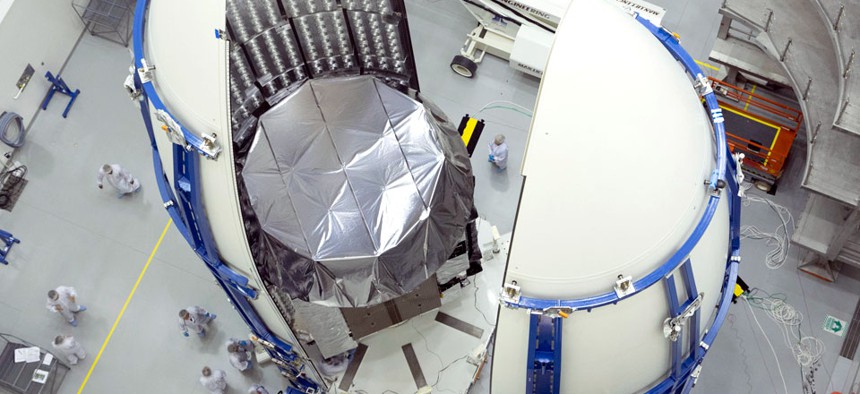Navy To Launch 2nd Broadband Satellite, Despite Lack of Terminals to Use It

The second MUOS satellite encapsulated into its payload fairing. Lockheed Martin via the U.S. Navy
Without terminals, the $7.3 billion system can only run at 10 percent, report finds.
The Navy plans to launch on Friday the second satellite in a fleet of six designed to provide high data communications to small shipboard and ground terminals, including Army manpack radios still under development.
The Mobile User Objective System, or MUOS, can transmit data at 384 kilobits per second, with terminals developed by General Dynamics C4 Systems and still undergoing tests, according to Navy Capt. Paul Ghyzel, program manager at the Satellite Communications Program Office of the Space and Naval Warfare Systems Command.
The MUOS satellites use a waveform based on third-generation cellular communications technology developed by the now-defunct Joint Tactical Radio System program and adapted for use in Army manpack radios by General Dynamics.
The Government Accountability Office said in an April 24 report that more than 90 percent of the $7.3 billion system’s planned capability depends on compatible user terminals being developed. “Although the first MUOS satellite was launched over a year ago [Feb. 25, 2012], operational testing of MUOS with production-representative user terminals is not expected to occur until the second quarter of fiscal year 2014,” the report said.
General Dynamics said in an April 18 press release that its AN/PRC-155 manpack radio had completed secure radio-to-radio voice and data communications tests through the MUOS network. The company said the radios used during the MUOS test were among the first delivered to the Army through a contract to produce more than 3,800 PRC-155 manpack radios.
The company did not respond to queries from Nextgov on when it plans to incorporate the wideband waveform in production radios.
Ghyzel told a media briefing he expected a number of manufacturers would eventually develop terminals to work with the MUOS satellite system, including handheld radios. Dennis C. Moran, vice president of government business development at Harris RF Communications, said his company has an AN/PRC-117G manpack radio ready to host the MUOS waveform via a software upgrade. “Similarly, the two-channel radio we are developing for the Army manpack and handheld program is fully MUOS capable,” Moran said.
Until broadband radios are fielded, Ghyzel said, users will be able to tap into the MUOS legacy payload based on a previous generation of satellites, which transmit data at 2.4 kbps.
The MUOS satellites are slated to replace older UHF Follow-On satellites, and due to the 26-month delay in the launch of the first MUOS satellite, the Navy has leased capacity on commercial satellites through agreements with the Australia Defense Force and the British Defense Ministry.
Ghyzel said the Navy plans to launch three MUOS satellites annually over the next three years, followed later by an on-orbit spare.
NEXT STORY: Face Time or Flex Time?



